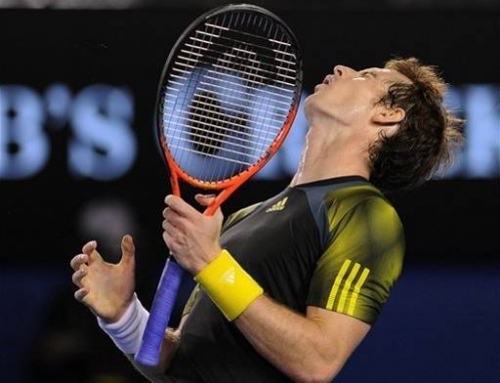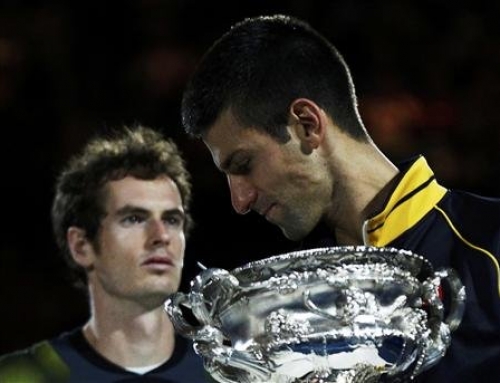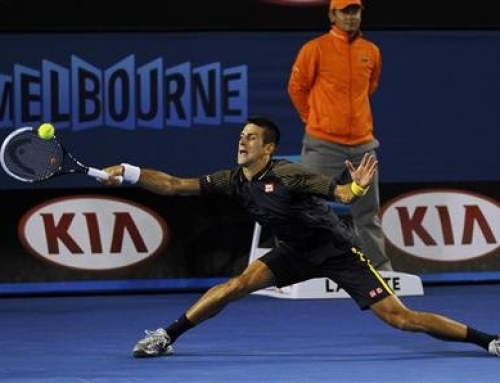Rafael Nadal must be so thrilled.
He had come off a tough four set challenge from the Swiss maestro who, once again, could not figure out a way to beat the beast of Mallorca. They say, in football, a good defense wins championships, and Rafa showed, if you can chase enough would-be winners, your opponent is going to make an error.
This was a long match, but aren’t they all long for Rafa? Rafa is about the only player who can play two sets 61 61 and still require two hours to accomplish the feat. Rafa doesn’t know quick play.
So he had to be happy when his big rival, Novak Djokovic, the Serb that has gotten into the his head had to spend nearly five hours on court for a victory against the once hapless, Andy Murray.
Not that this would be a wise feeling, and not that Rafa is so immodest or so naive to believe Djokovic couldn’t come back. After all, wasn’t it Djokovic who needed five sets to beat Roger Federer at the US Open last year before beating Rafa in four sets in the final? Wasn’t it the same Serb that had a gruelling three set match in Rome against the same Andy Murray and waltzed into the finals with a straight set win. Perhaps it’s a dried plum eaten under the cloak of a towel that provides Samson-like strength to the world number one?
Rafa only need look in the mirror to find someone who had to weather such a storm. Three years ago, Rafa found himself battling his own countryman, Fernando Verdasco, in a semifinal tussle for the ages. Verdasco, incidentally, had himself come off a five setter in the quarterfinals against whom? Yes, Andy Murray. Murray had been sick that Australian Open, but mustered the will to push Fernando five sets before succumbing. Everyone felt that Rafa could not possibly recover with one day off and give Federer a challenge. Not that Roger would try to slow ball the match and make Rafa run. Roger knows only one way to play, and that’s quick, and he alters this strategy for almost no one.
Rafa won this marathon in five sets as Roger, who clawed his way to a four set win, found himself unable to hit the ball in the court and surrendered an early break. Maybe tears weren’t shed then, but on the inside, Roger must have despaired. To play so well to take the fourth set, and then to yield a break so soon? And before he knew it, another break. And then the tears flowed for real. Don’t feel bad Roger, that year was nearly one of your best. Had del Potro not threaded the needle twice as you serving for the second set at Flushing Meadows, 2009 would have gone down as one of your most awesome years.
But, back to the match which was so much less about Rafa and Novak then it was about Andy Murray.
In early 2008, Andy Murray had been with a new coach, Miles Maclagan, and was finally addressing the one issue that his critics complained about most. His fitness. Murray was certainly talented enough to win or contend for matches against the best player. He took Rafa to five sets in Australia as a young lad. But the Scot was known to fade, his fitness faltering in the wee hours of a set, and with it the hopes of a nation so desperate for a winner that it would embrace a Scot. Murray entered the Australian Open hoping to make good on this new partnership only to be surprised by a player ranked in the 40s who was destined for his own greatness: Jo-Wilfried Tsonga.
That innocuous first-round upset lead to win after win, until the Frenchman met the Spaniard in the semifinal. How rare that defeat of Rafa was! Tsonga charged the net to deft drop volleys. He challenged the Mallorcan from the baseline. How did he do this? It was nearly as magical as Rafa’s own breakout party, a straight set win over the world number one in 2005 Miami.
Tsonga was stopped from his goals by Novak Djokovic who found ways to beat a mono-stricken Roger Federer in the semifinals. Djokovic hoisted the trophy of champion above his head. Surely, the Serb must have imagined hoisting many more. Little did he realize he would have to toil three more years, though ups and downs, through retirements from Slams and a year of more double faults than aces, before he could reclaim the title again, and surpass that with the best year of his life.
But, Andy Murray.
Andy Murray would take a serious step to his goals in 2008. Hiring a team that worried about strategy and fitness, Murray would give his team hope in Wimbledon 2008 when, in the fourth round, he faced a player that had troubles him before. Richard Gasquet. Murray clawed his way to a five set victory, and flexed a bicep, an audacious display. He would reach the semis and lose to Rafael Nadal, the first of many such experiences. Murray would then lose early in the Olympics to then unheralded Yen-Hsun Lu, he of Taiwan, but then of Chinese Taipei to placate the mainland who mince such political niceties in true Orwellian fashion.
Murray’s loss meant better prep for the event in New York. And the Olympic travails of the best players in the world meant Rafa was worn out, once again, heading into New York. At the time, the spectacular Spaniard was only good for half a year. He played amazing until Wimbledon, then his game or body wound down and he was vulnerable the rest of the year, assuming he could actually finish it. Indeed, he had never so much as reached a US Open semi until 2008. And that was when Murray put on the performance of his career, and toppled the Spaniard in a match that crossed two days. But Murray was only good enough to beat one champion that tournament, not two, and Federer, who had had an off-year by his lofty standards, held the trophy up high on that Monday.
Since that day, Murray made it to the finals of a Slam twice more, once in 2010 when Roger Federer again dispatched him in three sets, and once again a year later, when the super Serb, Novak Djokovic, bounced him similarly.
And here it was, a year later, and Murray hoping to reach the finals once again.
The start was hardly audacious. All the demons that surfaced in the years before at the biggest stages seemed to come again. Even the mighty Ivan Lendl, hired to provide the resolve to the hapless Scot seemed to fade as Murray spewed errors against Djokovic and Djokovic, unexpectedly popped in second serves that looked like first serves. And the first set was gone 63. Oh Andy, why can’t you play your best? Must you choke on the biggest stages?
Djokovic wasn’t playing his best by any means, but his level didn’t dip as much. With a break in the second set and a chance to break again, the new Andy Murray looked like warmed over old Andy Murray. And then Murray held off ignominy for one more moment and held his own serve. Then, began a series of breaks. Murray broke back! Murray had been having good luck with this. Against Nishikori, Murray should have had a trouncing. He had tons of break opportunities, but his opponent dug out of deep holes to hold serve, despite chances and chances and chances. At the time, this was attributed to Nishikori’s fatigue and that fatigue contributing to easy chances by Murray to break.
But Murray is a bit underrated as a returner. Yes, he possesses a great return, but enough to have break opportunities even against the best? Like he did against Nishikori, Murray had ample opportunities to break. Had he closed out on all the opportunities presented, he would be the one facing Rafa. But Djokovic would also earn back those points and hold when Murray should have broken.
Murray would break again and take the second set 63. Ah, there is fight left.
And the third set would see Murray break for a lead only to surrender the lead. Off to tiebreak and Murray would have a minibreak and yield a minibreak, before securing two points on Djokovic’s serve and riding to a 7-4 win in the tiebreak.
Murray’s new guru, Ivan Lendl, had told him before the match, that he would feel pain before victory. That no matter how hunched over his opponent may be, no matter how labored his breathing, Djokovic would still run. Murray heeded that warning. He ran around the Serb and watched him bend over, and Murray continued to fight the good fight. But not only was Djokovic’s fitness being tested, so was his.
When that third set concluded, Murray yielded a break immediately, then another. Two breaks down and Murray finally held serve. He had chances to break which might have at least stemmed the flow of defeat, but Djokovic held. And then Murray, realizing that it would take too much energy to claim the fourth with chances very good he’d play a fifth anyway, yielded the fourth quickly. Alas, he didn’t even bother to hold his own serve.
The two fought, but Murray found himself a break down, 52. Murray held, then broke Djokovic at love, and held again to 5-all and the momentum, as well as crowd support, fell Murray’s way. Murray wanted another break, the rush of adrenaline from being so close to his dreams pushing him forward. Murray would get to break points only to see the Serb, who wasn’t ready to yield despite being pushed all over, thread a down-the-line shot for a winner. Djokovic would hold serve, then Murray would find himself 15-40 down and then yield to the world number one.
But this time, critics who booed his inability to push his opponents would say that Murray had made a step forward, that he would fight more than himself.
And Djokovic would escape this one, and wonder if he could do as he did before against Nadal, as Nadal did once against Roger Federer. Could he recover in time to play his great nemesis once again, Or would the Spaniard, after being foiled for all of 2011, finally exorcise his own demons?
The answer–in a day.






![[Aussie Open Final] Can Andy Murray beat Novak Djokovic?](https://www.essentialtennis.com/wp-content/uploads/2013/01/20130126andy-500x383.jpg)
![[Day 13, Aussie Open] Bryan brothers win 13th Slam with Aussie doubles title, Kyrgios wins boys title](https://www.essentialtennis.com/wp-content/uploads/2013/01/20130125bryan-500x383.jpg)